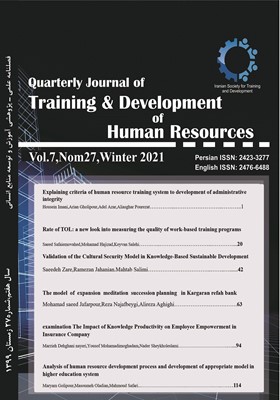واکاوی فرآیند توسعه منابع انسانی و تدوین الگوی مناسب در نظام آموزش عالی
الموضوعات : روش های نوین آموزش وتوسعه منابع انسانیمعصومه اولادیان 1 , مریم گلی پور 2 , محمود صفری 3
1 - دانشگاه آزاد اسلامی دماوند
2 - دانشگاه آزاد دماوند
3 - دانشگاه آزاد دماوند
الکلمات المفتاحية: نظام آموزش عالی توسعه منابع انسانی واکاوی فرآیند توسعه منابع انسانی,
ملخص المقالة :
هدف پژوهش حاضر واکاوی فرآیند توسعه منابع انسانی و تدوین الگوی مناسب در نظام آموزش عالی و روش آن به صورت آمیخته (کیفی و کمی) بود. جامعه پژوهش در بخش کیفی عبارت بودند از اساتید، متخصصان و خبرگان در این حوزه و در بخش کمی عبارت بودند از اساتید، صاحب نظران، کارشناسان و مدیران نظام آموزش عالی. تعداد نمونه در بخش کیفی که به صورت هدفمند انتخاب شد، 12 نفر از اساتید، متخصصان و خبرگان و در بخش کمی، با استفاده از فرمول کوکران382 نفر از کارشناسان و مدیران نظام آموزش عالی، انتخاب شدند. ابزار تحقیق عبارت بود مصاحبه نیمه ساختار یافته و پرسشنامه محقق ساخته. تجزیه و تحلیل داده های جمع آوری شده، در بخش کیفی به روش گراندد تئوری و از طریق کدگذاری (باز، محوری و انتخابی) با استفاده از نرم افزار MAXQDA و در بخش کمی به دو روش توصیفی و استنباطی با استفاده از نرم افزارهای SPSS 16 و Smart PLS انجام شد. نتایج نشان داد دوازده مولفه در تبیین واکاوی فرآیند توسعه منابع انسانی و تدوین الگوی مناسب در نظام آموزش عالی نقش دارند که عبارتند از؛ خودکار آمدی، عزت نفس، انگیزه، توانمندسازی، یادگیری سازمانی، فرهنگ سازمانی، مدیریت دانش، فناوری، رضایت شغلی، توسعه جامعه، تسهیل شبکهسازی، و در نهایت توسعه سرمایه انسانی. جهت بررسی برازش مدل، به بررسی X2، R و RS؛ پرداخته شد که وجود X2 پایین و نسبت کاي دو به درجه آزادي کمتر از سه، و همچنین ضریب تعینن و ضریب تعیین تعدیل شده محاسبه شده؛ نشاندهنده برازش مناسب مدل بود.
1. Abbaspour et al. (2016), the Use of Future Strategies and Human Resources Empowerment and Productivity in
Education, Case Study: Tehran Province Education Bureau... 2. Ahmed, A, Arshad, M. A, Mahmood, A, & Akhtar, S. (2016). Holistic Human Resource Development: Balancing the
Equation through the Inclusion of Spiritual Quotient. Journal of Human Values, 22(3), 165-179. 3. Alagaraja & Wang, P. M. 2012. Human Resource Management: Gaining a Competitive Advantage. 3rd ed. Boston: Mc
Graw-Hill. 4. Anderson(1999). The HR Wheel (Online) Available at: http://www.astd.org/virtual_community/
comm._careers/competencies/ hrwheel.htm 5. Anderson, V. (2017). HRD standards and standardization: where now for human resource development?. Human
Resource Development International, 20(4), 327-345. 6.
Barifaju (2016), Technology Adoption in Human Resource Management in Higher Education Institutions. 7.
Baron, A., & Armstrong, M. (1998). Human Capital Management: Achieving Value Through People. London: Kogan Page. 8.
Bassi, L. J., & Mc Murrer, D. P. (2008). Maximizing Your Return on People.Hardward Business Review, 8 (71), 32-42. 9.
Benitez et al 2016. "Human Resource Management in Higher Education: 13 10.
Greasly, K. Bryman, A. Pric, A. Naismith, N. Soetanto, R. (2008) “Understanding Empowerment from on Employee Perspective”, Team Performance Agement, 14(1/2):39-55. 11. Tonke Nejad, Mandani and Davari, Ali (1391). Human resource development with the sociological approach of the
organization, Quarterly Journal of Human Resource Management Research, Imam Hussein University, first year, No. 3. 12. Armstrong. Michael, (2005) Strategic Human Resources Management (Practice Guide) Seyed Mohammad Arabi and
Davood Izadi, Tehran, Cultural Research Office. 13. Ramezanpour, Farajollah (2016). Designing and explaining the investment model in human resources to gain a competitive advantage in knowledge-based industries; A case study of the pharmaceutical industry. Doctoral dissertation,
Shahid Beheshti University. 14. Shams, Shahabuddin Esfandiari Moghadam, Amir Teymour, (2015). The relationship between different dimensions of organizational trust and job satisfaction of employees. Scientific-Research Quarterly of Management Studies
(Improvement and Transformation), Twenty-Third Year No. 77, Spring and Summer 2015. 171-185. 15. # #Brown, J., & Bellulo, L. (2000). Satisfaction with public services: a discussion paper. Performance and Innovation 16.
Uddin et al (2015), Human Resource Development Research through Business Teachers Training in Bangladesh 17.
Sparkman T E. Human Resource Development in Brazil: National Challenges International Issues, Human Management International Digest, 2015; 24: 25-39 18. Smith PA, Birney LL (2005). "The organizational trust of elementary schools and dimensions of student bullying", Int. J.
Educ. Manage, 19(6): 469-485. 19. Garavan, Thomas N. (2007). Exploring HRD: A Levels of Analysis Approach, Human Resource Development Review. Vol. 3, No. 4, pp. 417-44
1. 20.
Karanj, (2018), Explores the Impact of ICT Integration on Human Resource Management in Kenya Public Universities. 21. Chivare (2010), A Study on Putting the Technical University Library in Higher Education and Human Resource
Development in Africa.


